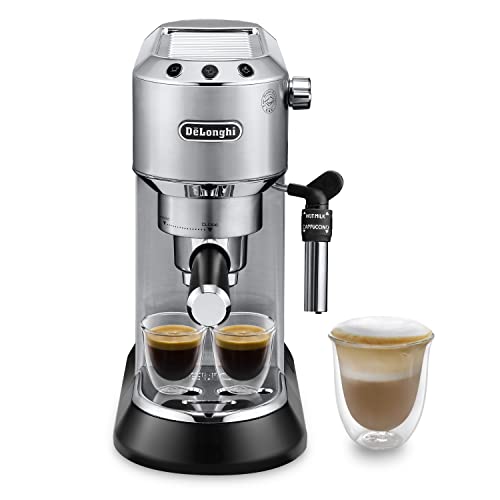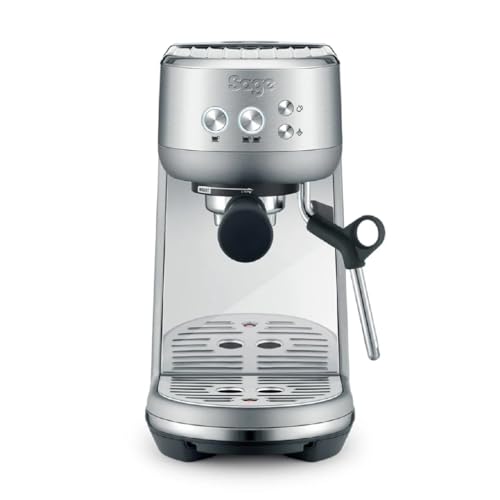Coffee Machines Espresso Tools To Improve Your Daily Lifethe One Coffe…
페이지 정보

본문
Coffee and Espresso Machines
Espresso machines make use of pressure to push water through finely ground and tamped coffee beans. They create a rich, delicious brew.
 Good Housekeeping Institute experts recommend models that can be brewed with 9 bars minimum for a perfect extraction. Beware of brands who claim to use more pressure than is needed.
Good Housekeeping Institute experts recommend models that can be brewed with 9 bars minimum for a perfect extraction. Beware of brands who claim to use more pressure than is needed.
Types
The espresso machine, sometimes called a coffee or espresso maker, produces the more concentrated, premium coffee you love from your favorite cafe drinks with an average of 9 bars of pressure. These machines typically have various features, including temperature control and brew strength as well as programmable brewing and different sizes of drinks. Some machines might have manual or automatic steam wands for creating texturized milk for latte art. There are three kinds of latte art: semi-automatic, super-automatic and automatic. Each espresso machine comes with its own specific level and type of automation.
Semi-automatic espresso Machines Espresso are the most popular in specialty coffee shops. Semi-automatic espresso machines permit baristas full control of the brewing process, but aren't as user-friendly as fully automatic or automated machines. To get the most perfect espresso shot, you must grind the beans, fill the portafilter, tamp it down, and adjust the time of extraction.
Automated machines have a built-in grinder which measures and mill the grounds for you. They automatically pour the correct amount of water to make the espresso, and they often feature a programmable drink size function. They were the most common espresso machine in our lab tests, and they offer a good balance between consistency and human control.
Functions
You'll need a reservoir hold the water you use for making coffee, whether you choose a steam-driven or pump-driven machine. You'll also have heating elements that heat the cold water in order to create the pressure necessary to extract coffee from the grounds.
When the brew lever gets raised, it triggers the water inlet cam to close the valve to prevent pre-infusion. This ensures that only hot water that is pressurized thoroughly flows through the portafilter into ground coffee. The water takes around 25 seconds before it turns into espresso.
The insulated tubing referred to as the hot-water tubing runs from the reservoir to the spout that is on top of your machine. The resistance heating element warms the water as water passes through the aluminum tube and metal warming plate.
Once the spout is activated, you'll put your cup under the spout to capture the espresso as it flows through the portafilter and into your cup. The coffee maker also have a steam wand, that you can use to heat and froth milk to make beverages that contain espresso like cappuccino or Latte.
Automatic machines eliminate the guesswork of making coffee. They are simple to use, programmable, and can measure and grind beans and bean to cup espresso machines tamp down. They typically have the best overall performance in our Lab tests since they are easy to operate and don't require any users' skills.
Materials
The inside of an espresso machine is a jungle of copper tubes, boilers made of stainless steel and intelligent firmware. Although they appear to be complex however their main purpose is to force hot water into finely ground coffee.
When choosing an espresso maker, think about dimensions and space requirements, drink options, energy-saving options and brewing accuracy. Also, look for a knob that can activate the steam wand to froth milk and making latte art. The front of the machine features the pressure gauge which will provide the operating pressure of the boiler and pump. You should look for a coffee maker with two needles to show the minimum and maximum pressure.
If you are looking for more than just espresso then choose a machine with different sizes of brew. This includes the ristretto. There are models that include the ability to remove the milk hopper for easy, hands-free frothing as well as the ability to switch between various types of milk. Choose a model that has an inbuilt softener, if you have hard water. This will help prevent mineral accumulation and ensure fresh espresso.
Certain manufacturers employ a PID (proportional, integral digital) thermostat to keep the temperature of espresso brewing. This feature guarantees a excellent espresso cup every time. This feature can also help reduce costs for energy because the machine only functions when needed.
Maintenance
The care and maintenance of coffee and espresso machines for home machines is becoming more important as they become more available to home use. The right equipment can make all kinds of distinction in your cup of coffee, but it's only true if your machine is in good working order.
Regular maintenance and cleaning needs to consist of everything from cleaning the steam wand, group head and water filter, to descaling and changing the water filter regularly. As a general rule when you're making between two and five cups of coffee every day, you should wash all parts of the machine once a week. However, some components of the machine, such as the grinder and water tank should be cleaned every two or three weeks.
It is also recommended to flush the machine each week. This is done by placing the portafilter in its place and running the brew cycles a few times. This will remove any coffee and espresso maker grounds or oils that remain. You can also use a brush or cleaner designed specifically for espresso machines to clean the portafilter.
Maintaining your espresso and coffee machine correctly can also ensure that it lasts longer. It is important to take care of the expensive espresso machine.
Espresso machines make use of pressure to push water through finely ground and tamped coffee beans. They create a rich, delicious brew.
 Good Housekeeping Institute experts recommend models that can be brewed with 9 bars minimum for a perfect extraction. Beware of brands who claim to use more pressure than is needed.
Good Housekeeping Institute experts recommend models that can be brewed with 9 bars minimum for a perfect extraction. Beware of brands who claim to use more pressure than is needed.Types
The espresso machine, sometimes called a coffee or espresso maker, produces the more concentrated, premium coffee you love from your favorite cafe drinks with an average of 9 bars of pressure. These machines typically have various features, including temperature control and brew strength as well as programmable brewing and different sizes of drinks. Some machines might have manual or automatic steam wands for creating texturized milk for latte art. There are three kinds of latte art: semi-automatic, super-automatic and automatic. Each espresso machine comes with its own specific level and type of automation.
Semi-automatic espresso Machines Espresso are the most popular in specialty coffee shops. Semi-automatic espresso machines permit baristas full control of the brewing process, but aren't as user-friendly as fully automatic or automated machines. To get the most perfect espresso shot, you must grind the beans, fill the portafilter, tamp it down, and adjust the time of extraction.
Automated machines have a built-in grinder which measures and mill the grounds for you. They automatically pour the correct amount of water to make the espresso, and they often feature a programmable drink size function. They were the most common espresso machine in our lab tests, and they offer a good balance between consistency and human control.
Functions
You'll need a reservoir hold the water you use for making coffee, whether you choose a steam-driven or pump-driven machine. You'll also have heating elements that heat the cold water in order to create the pressure necessary to extract coffee from the grounds.
When the brew lever gets raised, it triggers the water inlet cam to close the valve to prevent pre-infusion. This ensures that only hot water that is pressurized thoroughly flows through the portafilter into ground coffee. The water takes around 25 seconds before it turns into espresso.
The insulated tubing referred to as the hot-water tubing runs from the reservoir to the spout that is on top of your machine. The resistance heating element warms the water as water passes through the aluminum tube and metal warming plate.
Once the spout is activated, you'll put your cup under the spout to capture the espresso as it flows through the portafilter and into your cup. The coffee maker also have a steam wand, that you can use to heat and froth milk to make beverages that contain espresso like cappuccino or Latte.
Automatic machines eliminate the guesswork of making coffee. They are simple to use, programmable, and can measure and grind beans and bean to cup espresso machines tamp down. They typically have the best overall performance in our Lab tests since they are easy to operate and don't require any users' skills.
Materials
The inside of an espresso machine is a jungle of copper tubes, boilers made of stainless steel and intelligent firmware. Although they appear to be complex however their main purpose is to force hot water into finely ground coffee.
When choosing an espresso maker, think about dimensions and space requirements, drink options, energy-saving options and brewing accuracy. Also, look for a knob that can activate the steam wand to froth milk and making latte art. The front of the machine features the pressure gauge which will provide the operating pressure of the boiler and pump. You should look for a coffee maker with two needles to show the minimum and maximum pressure.
If you are looking for more than just espresso then choose a machine with different sizes of brew. This includes the ristretto. There are models that include the ability to remove the milk hopper for easy, hands-free frothing as well as the ability to switch between various types of milk. Choose a model that has an inbuilt softener, if you have hard water. This will help prevent mineral accumulation and ensure fresh espresso.
Certain manufacturers employ a PID (proportional, integral digital) thermostat to keep the temperature of espresso brewing. This feature guarantees a excellent espresso cup every time. This feature can also help reduce costs for energy because the machine only functions when needed.
Maintenance
The care and maintenance of coffee and espresso machines for home machines is becoming more important as they become more available to home use. The right equipment can make all kinds of distinction in your cup of coffee, but it's only true if your machine is in good working order.
Regular maintenance and cleaning needs to consist of everything from cleaning the steam wand, group head and water filter, to descaling and changing the water filter regularly. As a general rule when you're making between two and five cups of coffee every day, you should wash all parts of the machine once a week. However, some components of the machine, such as the grinder and water tank should be cleaned every two or three weeks.
It is also recommended to flush the machine each week. This is done by placing the portafilter in its place and running the brew cycles a few times. This will remove any coffee and espresso maker grounds or oils that remain. You can also use a brush or cleaner designed specifically for espresso machines to clean the portafilter.
Maintaining your espresso and coffee machine correctly can also ensure that it lasts longer. It is important to take care of the expensive espresso machine.

- 이전글Don't Believe In These "Trends" About Mazda 5 Key Fob 24.08.26
- 다음글Kegirangan Bermain Slots Online 24.08.26
댓글목록
등록된 댓글이 없습니다.

